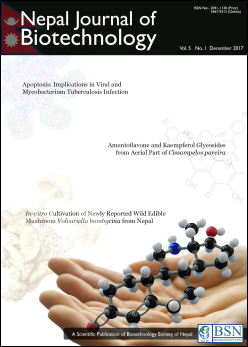Antibiotic Resistance Pattern of Shigella spp. Among Gastroenteritis Patients at Tertiary Care Hospital in Pokhara, Nepal
DOI:
https://doi.org/10.3126/njb.v5i1.18865Keywords:
Shigella, Antibiotic Resistance Pattern, Shigellosis, Gastroenteritis, Tertiary Care Hospital, NepalAbstract
Shigellosis, a disease caused by Shigella species. It is a major public health problem in developing nations like Nepal, where communities having poverty; poor sanitation, personal hygiene, and water supplies. The main aim of our study is to isolate and identify Shigella spp. from gastroenteritis patients and to find out its drug resistance pattern.
A cross-sectional study was carried out based on routinely attending outpatients and inpatients. A total of 225 stool samples collected from gastroenteritis patients were processed from 20 April to 24 September 2014 in Western Regional Hospital, Pokhara, Nepal. Standard microbiological procedures were followed for the isolation of Shigella spp. After that slide agglutination kit method was used for identification of Shigella spp. Finally, Kirby-Bauer disc diffusion method was done for an antimicrobial resistance test.
Of the total 225 gastroenteritis patients, 133 were detected as bacterial positive cases. Among positive cases, Shigella spp. was identified in 10.5%. Age wise, an infection rate of Shigella in patients <15-years old was found higher i.e. 7.3% than in patients ≥ 15 years old i.e. 4.5% with the (p = 0.432) at 95% CI. The infection rate of S. dysenteriae, S. flexneri, and S. sonnei was detected in 28.6%, 57.1%, and 14.3% respectively. For the antimicrobial test, eight types of antibiotics were used. The most resistance pattern of isolated Shigella spp. was found in nalidixic acid, and co-trimoxazole 92.8% followed by ampicillin 64.3% and ciprofloxacin 42.8% etc.
Our study reported that endemicity of Shigellosis with S. flexneri is the predominant group in gastroenteritis patients. This finding suggests that co-trimoxazole, nalidixic acid, ciprofloxacin and ampicillin should not be used experimentally as first-line drugs for shigellosis treatment.
Downloads
Downloads
Published
How to Cite
Issue
Section
License
Copyright Notice:
The manuscript submitted to NJB must be an original contribution, not previously published and should not be under consideration for publication elsewhere. When the manuscript is accepted for publication, the authors agree to automatically transfer the copyright of the article to the publisher. It should grant permission to any third party, in advance and in perpetuity, the right to use, reproduce or disseminate your article, according to the NJB copyright and license agreement.
Authors transfer copyright to the publisher as part of a journal publishing agreement but have the rights to: Share their article for Personal Use, Internal Institutional Use and Scholarly Sharing purposes, with the NJB applies the Creative Commons Attribution-NonCommercial CC BY-NC license to all the works we publish after Jun 2020 (Before it was CC BY-NC-ND). Under this license, authors agree to make articles legally available for reuse, without permission or fees, for virtually any non-commercial purpose. Anyone may remix, adapt, and build upon your work non-commercially, and although their new works must also acknowledge you and be non-commercial, they don’t have to license their derivative works on the same terms. More details on CC BY-NC refer to its Licence Deed and Legal Code.






